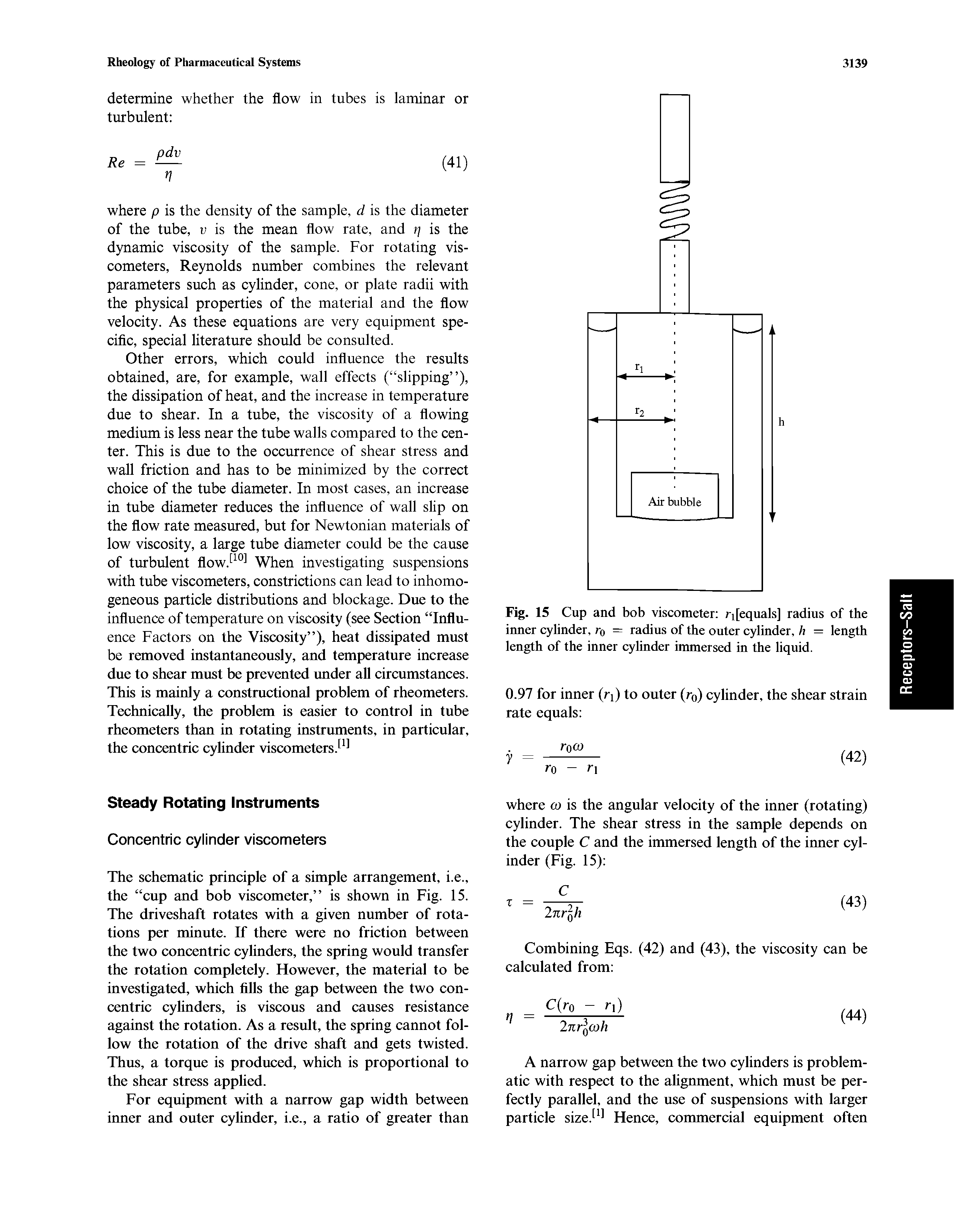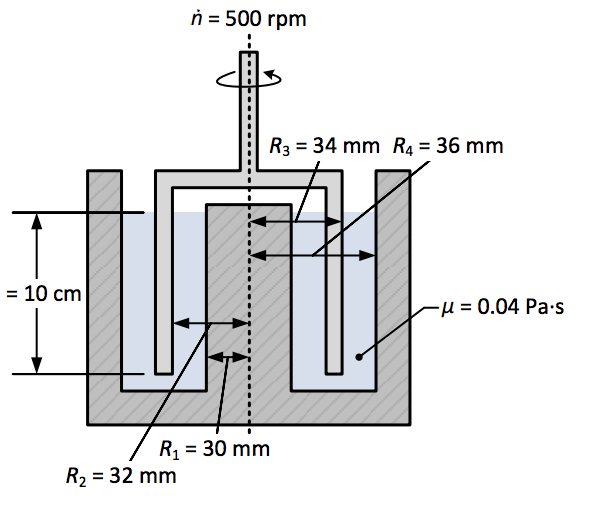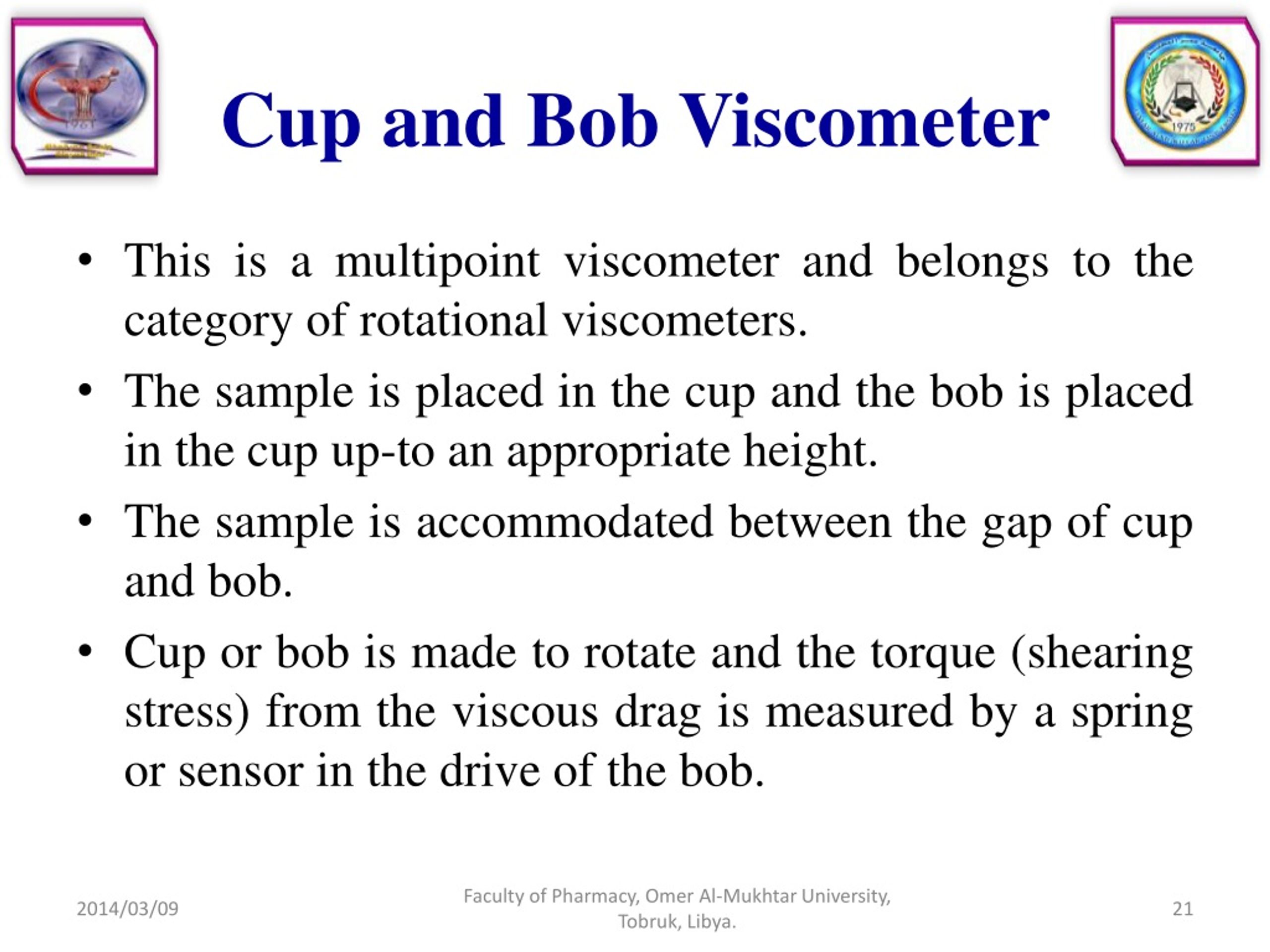
Anton Paar Disposable Measuring system Cup D18 and bob CC12 for ViscoQC
Viscometry is the experimental determination of the viscosity of liquids and gases with so-called viscometers. Definition of viscosity (Newton's law of fluid friction) Viscosity describes the internal resistance to flow of a fluid (internal friction). It is defined by the shear stress τ required to shift two plates moving relative to each other.

cup and bob Big Chemical Encyclopedia
Context 1. measuring fluid is now located between the cup and the rotor. In figure 1 the setup of a "cup and bob" rotational viscometer is shown. There are two different kinds of "cup.

Cup and Bob physical pharmaceutics Physics, Bob, Cup
As the name implies, the cup-and-bob viscometer consists of two concentric cylinders, the outer "cup" and the inner "bob," with the test fluid in the annular gap (see Fig. 3-2). One cylinder (preferably the cup) is rotated at a fixed angular velocity (Q).

4Paint Viscosity Test Cup Flow Mixing Thinning 100mml
Coaxial rotational viscometer: These are also known as concentric cylinder viscometers. A bob that has a circular cross-section is placed inside a cup containing the test liquid. Either the cup or bob is rotated and the drag of the liquid on the bob is measured by a torque sensor. They are suitable for Newtonian and non-Newtonian liquids.

Cupand Bob Couette Fluid Mechanics Beyond Discovery
The rotational viscometer consists of two basic parts separated by the fluid being tested. The two parts may be: concentric cylinders (cup and bob), parallel plates, a low angle cone and plate, or a spindle inside of a cylinder. Common spindle shapes, disk, T-bar, cylinder, and vane, are shown below.

Hightemperature oscillatingcup (1) Oscillating initiator
1of 19 Rotational viscometers •8 likes•6,093views Report Share Download NowDownload to read offline Education Rotational Viscometers, typers and sub-types, advantages,disadvantages,working of different rotational viscometers. 2.cone and plate viscometer, plug flow development, etc. Chapter: Rheology 4th semester B.Pharm.

Setup of a " cup and bob " rotational (1) cup, (2
A viscometer (also called viscosimeter) is an instrument used to measure the viscosity of a fluid. For liquids with viscosities which vary with flow conditions, an instrument called a rheometer is used. Viscometers only measure under one flow condition.

Elongated double gap cup and bob (Klein et al, 1990
Disadvantages Rotational Viscometer. It can be fairly pricey. Large and immovable in many cases. Types of Rotational Viscometer Couette type Rotational Viscometer "Rotating-cup" The cup is rotated while the bob is constant. The viscous drag on the bob produced by the liquid results in a torque which is proportional to the viscosity of the.

Cup And Bob Supply of Science
Figure 1. Viscosity measuring ranges of available Ubbelohde capillaries over a wide viscosity range (logarithmic scale). Types of available glass capillaries Generally, gravimetric capillaries are made of glass. They are divided into direct-flow or reverse-flow models.

Flow Cup at best price in Ambala by Advanced Technocracy
The cup and bob viscometer setup involves a cylindrical bob rotating inside a coaxial cylindrical cup with the test material placed in the annulus between the two. The measurement is the torque required to rotate the bob at an angular velocity and this data is related to the shear stress and shear rate. The shear-stress-shear-rate rheogram is.

Cup and Bob working of cup and Bob Rheology
τ = 4πηlΩa2b2 b2 −a2 (20.4.7) (20.4.7) τ = 4 π η l Ω a 2 b 2 b 2 − a 2. In equilibrium, this is equal to cϕ c ϕ, where c c is the torsion constant of the suspension and ϕ ϕ is the angle through which the inner cylinder has turned, and hence the viscosity can be determined. You should, as usual, check the dimensions of Equation.

Diagram of a rotating bob Download Scientific Diagram
For all cases except where the gap between the cup & bob is very small, that is Rc/Rb > 0.95, we must correct for the flow field in the gap. When a more pseudoplastic fluid is tested, the shear rate in the gap. viscometers: Step #1, calculate the shear stress, on the bob using the equation for Newtonian fluids. Step #2, calculate the value.

PPT Rheology PowerPoint Presentation, free download ID9070540
This paper describes a number of methods used to measure the viscosity of liquid metals, including capillary, oscillating vessel, rotational bob or crucible, oscillating plate, draining vessel,.

Elongated double gap cup and bob (Klein et al, 1990
Details Viscometer / Viscosity Meter Viscometer PCE-RVI 2 £ 1,156.00 Price excl. VAT &. delivery 2 year Warranty The viscometer has a measuring range of 15. 100,000 cP. With an accuracy of <±2% of the range, the viscometer is a precise measuring device to determine the viscosity of a sample liquid. - Measuring range: 15. 100,000 cP

Figure 1 from Interpretation of Test Results for Polymer
A viscometer (also called viscosimeter) is an instrument used to measure the viscosity of a fluid. For liquids with viscosities which vary with flow conditions, an instrument called a rheometer is used. Thus, a rheometer can be considered as a special type of viscometer. [1]

Asky Instruments 240 V Flow Cup For Laboratory at Rs 2200
Dynamic viscosity, also known as absolute viscosity, is a fluid's resistance to shear flow due to an applied external force. It describes the amount of internal resistance offered when one layer of the fluid moves over another layer in a horizontal plane. Dynamic viscosity is especially useful when describing non-Newtonian fluids. Advertisement